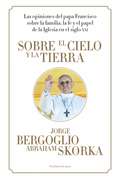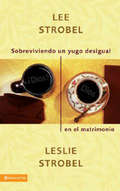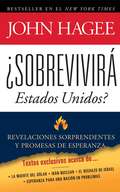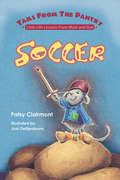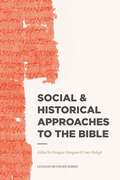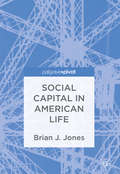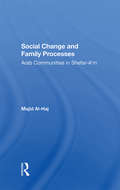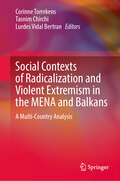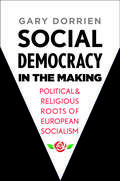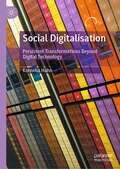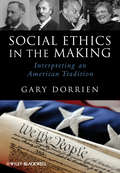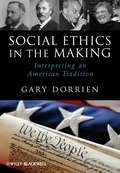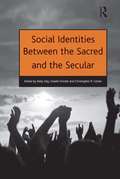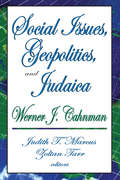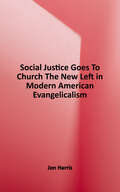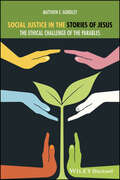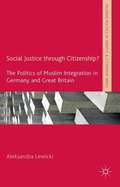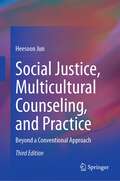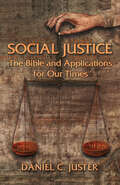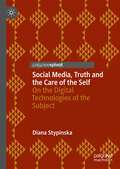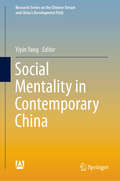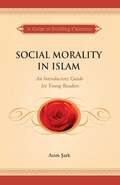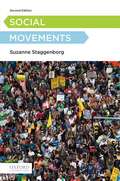- Table View
- List View
Sobre el cielo y la tierra: Las opiniones del Papa Francisco... (Vintage Espanol Ser.)
by Jorge Bergoglio Abraham SkorkaEl cardenal Jorge Mario Bergoglio, desde el 13 de marzo de 2013 papa Francisco, y el rabino Abraham Skorka, rector del Seminario Rabínico Latinoamericano, son dos tenaces promotores del diálogo interreligioso, a través del cual buscan construir horizontes comunes sin diluir las particularidades que los caracterizan. Jorge Mario Bergoglio y el rabino Abraham Skorka han forjado una fuerte amistad, sostenida en la mutua predisposición al diálogo interreligioso. Por primera vez, en esta oportunidad, se reúnen para hablar de temas religiosos y del mundo. Ambos son figuras destacadísimas en sus funciones: Bergoglio es Arzobispo y Cardenal de Buenos Aires -siendo el representante más alto del catolicismo en la Argentina- y Skorka es el Director del Seminario Rabínico Latinoamericano. Este libro se destaca por el profundo nivel alcanzado en los diálogos entre estas dos figuras y por el compromiso adquirido en la selección de los tópicos y en sus opiniones. Temas religiosos y espirituales como la existencia de Dios, la importancia de los líderes religiosos, la pobreza y la acción social; se complementan con otros más polémicos como el matrimonio gay, el aborto, el ateísmo, los fundamentalismos, la política, el poder, la dictadura. Sin dejar de lado otros tantos como: la fé, la ciencia, la educación y la vejez. Un libro fundamental para entender cómo piensan nuestra sociedad y el futuro de la religión, estos dos grandes líderes espirituales.
Sobrecarga: Cómo desconectarse, relajarse y soltarse a sí mismo de la presión del estrés
by Joyce Meyer#1 New York Times bestselling author Joyce Meyer shows readers how to become free from the burden of stress so that they can achieve God's best for their lives. As technology increases your accessibility, it becomes harder to mute the background noise of your life and receive God's guidance. Joyce Meyer calls this OVERLOAD, when the demands of your busy life become all-consuming and overwhelming. But to experience the joyful life God has planned, you must make time to focus on His Word. Then you'll receive His healing calmness and gain the strength to take on life's challenges, from physical ailments to problems in relationships. Through the practical advice and Scriptural wisdom in this book, you'll learn how to unplug and free yourself from burdens that weigh you down. You'll gain simple, effective tips for better rest and stress management and discover the fulfilling life you were meant to lead.
Sobreviviendo un yugo desigual en el matrimonio
by Lee Strobel Leslie StrobelSPANISH EDITION. Noted Christian communicator Lee Strobel and his wife team together to write a book about how to live with your unchurched spouse while living out your faith authentically in front of him or her.
Sobrevivira Estados Unidos: Revelaciones sorprendentes y promesas de esperanza
by John HageeThis new book by New York Times bestselling author and pastor, John Hagee, says the United States is heading into a “Perfect Storm.” Titanic. John F. Kennedy’s assassination. 9/11. John Hagee maintains that these American tragedies all have one element in common: they were unthinkable. And in the opening pages of his newest book, Can America Survive? Hagee uses these tragedies to prove two points: that the unthinkable can happen and, given the right conditions, the unthinkable can quickly become the inevitable.In Can America Survive? Hagee asserts that the seeds for tragedy are once again being sown, evidenced by the disturbing economic, geopolitical, and religious trends that now threaten to dismantle the very nation itself. “Think it can’t happen?” Hagee asks in a theme repeated throughout the book. “Think again.” Indeed, Hagee presents alarming examples of recent events, current research, scientific evidence, and biblical prophecy that are gathering to create a “perfect storm” that could bring down the “unsinkable” United States of America. Can America Survive? is not just a warning. It is a wake-up call and a rallying cry to Christian citizens everywhere to prevent the next unthinkable American disaster. After all, as Hagee points out, “those who do not remember the mistakes of the past are doomed to repeat them in the future.” Think it can’t happen? Think again.
Soccer
by Patsy ClairmontThere's a new cat in the house outside of the pantry. "I heard Whomp is a WILD cat!" Soccer hears from Tipsy the Spider who heard it from Chatter the ladybug who heard it from Dot the housefly "who saw it with her own seven eyes." When Soccer rushes home to tell his mom, she warns him not believe everything he hears. But when Soccer has to venture out to meet Tipsy for a game of checkers, he doesn't take any chances. In his suit of armor (a bike helmet, boxing gloves, winter boots, and a wooden sword), Soccer stumbles upon a ball of fur that is anything but "WILD." This adorably illustrated tale from the pantry will entertain children of all ages with the important lesson of being cautious of rumors.
Social & Historical Approaches to the Bible (Lexham Methods Series)
by Douglas Mangum Amy BaloghThe Bible was not written and received in a historical vacuum—in fact, the social and historical context of the Bible illuminates key understandings that may have been otherwise missed. Biblical scholars use many different approaches to uncover this context, each engaging various aspects of the social and historical world of the Bible—from religious ritual to scribal practice to historical event. In Social & Historical Approaches to the Bible, you will learn how these methods developed and see how they have been used. You will be introduced to the strengths and weaknesses of each method, so you may understand its benefits as well as see its limitations. Many of these approaches are still in use by biblical scholars today, though often much changed from their earliest form as ideas were revised in light of the challenges and questions posed by further research.
Social Analysis: Linking Faith and Justice
by Joe Holland Peter HenriotFor people of Christian tradition, this book is beautifully constructed for the work of social justice. Highly useful, deeply insightful.
Social Capital in American Life
by Brian J. JonesEmbarking from a model of social capital hinging upon four social structures—work, family, social networks, and voluntary associations—Brian Jones empirically examines the widespread claims that American society is becoming less sociable, trusting, and cooperative. Breaking down datasets drawn from the General Social Survey (conducted 27 times from 1972 to 2008), Social Capital in American Life depicts the social values drawn from the four established social structures, as well as their interrelationships, their determinants, and ultimately their social capital, through a series of statistical and econometric methods. This rigorous, empirically driven analysis reveals how American society both confirms and repudiates fears about decreased cooperation given different cases and parameters.
Social Change And Family Processes: Arab Communities In Shefar-a'm
by Majid Al-hajIn this book, Majid Al-Haj analyzes the structure of family kinship groups, the role of women, and fertility among several Arab subcommunities in Israel. He combines historical materials, anthropological evidence, and several major surveys in tracing family and demographic patterns in a developing Arab community. This study is the first to compare Moslems, Christians, and Druze over time in the same community and to integrate issues of modernization and population for minorities. Particular attention is given to the analysis of "internal refugees" among Moslems, the separation of structural from cultural determinants of family patterns, and the distinction between behavior and norms associated with family lifestyles. This volume represents a fascinating case study of an Arab town in the transition to modernity under the conditions of changing layers of minority status in Israeli society. Moreover, the author addresses broader issues of modernization and demographic change characterizing the Middle East and other developing areas of the world where minority ethnic conflict and population processes are intertwined.
Social Contexts of Radicalization and Violent Extremism in the MENA and Balkans: A Multi-Country Analysis
by Corinne Torrekens Tasnim Chirchi Lurdes Vidal BertranThis volume is a multilevel and multidisciplinary study of radicalization in the Balkans and MENA regions. It takes a dynamic approach embracing the complexity of the social, political and economic contexts under study. Moving away from unidimensional and security-centred research on the topic, each chapter adopts a participatory and inclusive perspective, engaging communities, youth and women as significant stakeholders in building a better understanding of the dynamics of the radicalization of youth in these regions. The multiple case studies presented here cover several macro drivers of radicalization to reveal the interactions and interrelations of individuals with meso-institutions and backgrounds such as family, neighbourhood, school, peer groups, religious and ethnic communities, political parties, etc. Consequently, the volume addresses several gaps in the literature regarding radicalization and violent extremism: it is based on firm empirical evidence; it allows for comparisons between social contexts in one specific country and between countries sharing macro similarities but also differences; it proposes a fruitful dialogue and collaborations between academics, researchers and civil society experts; and, finally, it offers decentralized perspectives on extremism in the West. This volume is an important addition to a topic that is of interest to researchers across the social sciences, and to think tanks and policy makers working on/in these regions.
Social Democracy in the Making: Political and Religious Roots of European Socialism
by Gary DorrienAn expansive and ambitious intellectual history of democratic socialism from one of the world’s leading intellectual historians and social ethicists The fallout from twenty years of neoliberal economic globalism has sparked a surge of interest in the old idea of democratic socialism—a democracy in which the people control the economy and government, no group dominates any other, and every citizen is free, equal, and included. With a focus on the intertwined legacies of Christian socialism and Social Democratic politics in Britain and Germany, this book traces the story of democratic socialism from its birth in the nineteenth century through the mid‑1960s. Examining the tenets on which the movement was founded and how it adapted to different cultural, religious, and economic contexts from its beginnings through the social and political traumas of the twentieth century, Gary Dorrien reminds us that Christian socialism paved the way for all liberation theologies that make the struggles of oppressed peoples the subject of redemption. He argues for a decentralized economic democracy and anti-imperial internationalism.
Social Digitalisation: Persistent Transformations Beyond Digital Technology
by Kornelia HahnThis book shows how many previously contingent social processes have gradually been re-organised and transformed into entangled processes of ‘discontinuance’ and ‘continuance’ through the implementation of digital logic. Together with the necessary co-evolution of our collective digital literacy, this persistent process of transformation throughout modernity is theorised here as one of ‘social digitalisation.’ Social digitalisation highlights the ways in which material digital technology, like preceding material technologies, has been fitted into the longer term trajectory of digital transformation. This new social theory thus reverses prevailing accounts of the ‘digital revolution’ that focus exclusively on changes allegedly caused by material digital technology in recent decades. The book also demonstrates the fruitfulness of applying the theory of social digitalisation as a holistic approach in researching the wide-ranging consequences of contemporary digitalisation, including its contrasting effects on different social groups. It will be useful to students and researchers of sociology, communications, media and history, but also for general readers interested in understanding the overall complexity of digitalisation and how digital transformation has come to dominate the ways we live today.
Social Ethics in the Making
by Gary DorrienIn the early 1880s, proponents of what came to be called "the social gospel" founded what is now known as social ethics. This ambitious and magisterial book describes the tradition of social ethics: one that began with the distinctly modern idea that Christianity has a social-ethical mission to transform the structures of society in the direction of social justice.Charts the story of social ethics - the idea that Christianity has a social-ethical mission to transform society - from its roots in the nineteenth century through to the present dayDiscusses and analyzes how different traditions of social ethics evolved in the realms of the academy, church, and general publicLooks at the wide variety of individuals who have been prominent exponents of social ethics from academics and self-styled "public intellectuals" through to pastors and activistsSet to become the definitive reference guide to the history and development of social ethicsRecipient of a CHOICE Outstanding Academic Title for 2009 award
Social Ethics in the Making: Interpreting an American Tradition
by Gary DorrienIn the early 1880s, proponents of what came to be called "the social gospel" founded what is now known as social ethics. This ambitious and magisterial book describes the tradition of social ethics: one that began with the distinctly modern idea that Christianity has a social-ethical mission to transform the structures of society in the direction of social justice.
Social Identities Between the Sacred and the Secular (Ashgate Ahrc/esrc Religion And Society Ser.)
by Christopher R. Cotter Abby Day Giselle VincettFocusing on the important relationship between the 'sacred' and the 'secular', this book demonstrates that it is not paradoxical to think in terms of both secular and sacred or neither, in different times and places. International experts from a range of disciplinary perspectives draw on local, national, and international contexts to provide a fresh analytical approach to understanding these two contested poles. Exploring such phenomena at an individual, institutional, or theoretical level, each chapter contributes to the central message of the book - that the ’in between’ is real, embodied and experienced every day and informs, and is informed by, intersecting social identities. Social Identities between the Sacred and the Secular provides an essential resource for continued research into these concepts, challenging us to re-think where the boundaries of sacred and secular lie and what may lie between.
Social Issues, Geopolitics, and Judaica
by Zoltan Tarr Werner J. Cahnman Judith T. MarcusThis volume brings together thirty-four essays and ar- ticles by Werner J. Cahnman representing four decades (1940-1980) of work by an extraordinary, multidisciplinary scholar. Cahnman's work encompasses the experiences of a German Jewish refugee, an economist turned sociologist, and a scholar of Judaism. Part 1 contains personal and autobiographical writings and includes analyses of the cultural ambiguities of Jewish assimilation in Germany and Austria. Part 2 is devoted to sociological essays ranging from a critical assessment of Gunnar Myrdal's landmark study of the problems of race and democracy, An American Dilemma, to a probing look at the stigma of obesity, based on empirical research, a subject very much in the news today and that shows Cahnman ahead of his time. Part 3 offers some of Cahnman's most perceptive essays dealing with geopolitical themes. Included are theoretically based writings that help to clarify the methods and concepts of geopolitics, marking the intellectual beginnings of the global approach to world affairs. Here Cahnman broached the possibility of a united Europe (1944), realized sixty years later in the formation of the European Union. The twelve essays of Part 4 return to Cahnman's ever-present concern with Jews and Judaism. They present a wide-ranging historical-sociological view, from the Jews of Vienna in the 1930s to the American scene in the 1960s, to the still-unresolved problematics of Arab-Israeli relations, with Cahnman arguing for coexistence and a two-state solution for Jews and Arabs. The volume, carefully selected and assembled by the editors, presents for the first time essays representing the full range of Werner Cahnman's scholarship and thought. It will be of interest to students of sociology, history, political science, and Judaic studies.
Social Justice Goes To Church: The New Left In Modern American Evangelicalism
by Jon HarrisIn order to understand why so many evangelicals recently support left-leaning political causes, it is important to know a little history. In the 1970s, many campus radicals raised in Christian homes brought neo-Marxist ideas from college back to church with them. At first, figures like Jim Wallis, Ron Sider, and Richard Mouw made great gains for their progressive evangelical cause. But, after the defeat of Jimmy Carter, the religious right stole the headlines. Today, a new crop of mainstream evangelicals has taken up the cause of the New Left whether they know it or not. As pro-life evangelicals rush to support movements like #BlackLivesMatter and #MeToo, it is important to realize they are walking in footprints already laid down. Their mission may be more successful, but it is not new. To understand where the evangelical social justice movement is heading, it is vital to understand the origins of the movement. Social Justice Goes to Church: The New Left in Modern American Evangelicalism answers, from a historical perspective, the vital question, "Why are American evangelicals moving Left?"
Social Justice in the Stories of Jesus: The Ethical Challenge of the Parables (Lived Religions)
by Matthew E. GordleyInvites a new generation of readers to apply ethical reasoning to social justice challenges, accessible to people of faith from a broad range of backgrounds Social Justice in the Stories of Jesus introduces readers to the parables of the New Testament while exploring how they relate to social justice, ethics, and key issues of modern society. Centering on themes of mercy, justice, and human dignity, this unique volume invites readers to reflect on the meaning of Jesus's parables both in their original setting and in the context of present-day moral and ethical challenges. The author discusses social justice concepts from various traditions to enable readers to engage with the ethical implications of the parables in a range of different contexts. Each chapter focuses on one parable or set of parables, such as the parable of the Good Samaritan and the parable of the Pharisee and the Tax Collector, and includes historical background information and an analysis and interpretation of the parable. Throughout the text, the author highlights the connections between Jesus's parables and racism, violence, poverty, the environment, our obligations to one another, and other timely social justice issues. Blends an accessible overview of the parables of Jesus with an introduction to social justice and ethics Explores New Testament parables as viewed through the lens of contemporary writers, ethicists, and activists Emphasizes the Jewish roots of the parables and the need to guard against anti-Jewish readings of the parables Highlights the ways that Jesus’s parables challenged his first-century listeners to see their world in new ways and recognize the dignity of every person Engages with seminal thinkers in contemporary social justice, such as James Cone, Howard Thurman, Emilie Townes, Bishop Michael Curry, and Pope Francis Includes study and discussion questions for personal and group use Requiring no prior knowledge of the subject, Social Justice in the Stories of Jesus: The Ethical Challenge of the Parables is an ideal textbook for introductory courses on the Bible and New Testament, faith-based courses on ethics, and general Christian readers looking for an excellent resource for personal or congregational study.
Social Justice through Citizenship?
by Aleksandra LewickiLewicki examines how current salient discourses of citizenship conceptualize democratic relations and frame the 'Muslim question' in Germany and Great Britain. Citizenship is understood not as a static or monolithic regime, but as being reproduced through competing discourses that can facilitate or inhibit the reduction of structural inequalities.
Social Justice, Multicultural Counseling, and Practice: Beyond a Conventional Approach
by Heesoon JunThis third edition book offers a paradigm shift in thinking (from binary to complex) and enables visibility for the intersectionality of multiple identities that range from privileged to oppressed. For example, real people’s heterogeneous racial identities within the same racial group are visible. A paradigm shift in learning (from conceptual to transformative) connects conceptual learning (cognition) to their experience (affect). “…. transformation does not simply emerge due to the individual’s awareness…. but is experienced” (Benetka & Joerchel, 2016, p. 22). Uncensored first-person (subjective) written responses to specific questions to access unconscious and implicit bias will connect the writer’s experience to conceptual learning of diversity, equity, and inclusion. Writing in third person (objective) interrupts the transformative aspect by bypassing the accessibility of inner experience. Writing in first-person connects the writer to their experience which allows the unconscious to be accessed if it is practiced on a regular basis. This book is for everyone who wants to implement diversity, equity, and inclusion measures by learning to access their unconscious bias. Understanding social justice and equity and good intentions alone do not lead to accessing unconscious bias.
Social Justice: The Bible and Applications for Our Times
by Daniel Juster, Th.D.Justice, as a concept, mostly refers to all members of a society getting a just deal in provision and opportunity. As contrasted to legal justice before courts, where there is just restitution for crimes, resolution of conflicting claims for pay, inheritance and punishment for crimes, social justice is very connected to economic justice. Deuteronomy 17:10, affirms, Justice and only justice you are to pursue. (From the introduction)
Social Media, Truth and the Care of the Self: On the Digital Technologies of the Subject
by Diana StypinskaThis book explores the relationship between (post)truth and subjectivity by focusing on social media as a site of digital subjectification. These days, truth is cheap. Anyone can claim it. Indeed, most do – impudently and without any recourse to facts or objective reality. Truth-claims today are nothing but power grabs, employed in the permanent popularity contest that our culture and politics have become. Correspondingly, our very sense of reality is perpetually uprooted. Post-truth sets us adrift. Navigating by smartphones, we pursue endless mirages, coming to wonder whether the shoreline itself is a myth. The book examines the ways in which different digital practices – such as influencing, trolling and digital activism – operate as technologies of the subject, shaping how we relate to ourselves, others and the world. It argues that social media facilitates the progressive eclipsing of our subjective (dis)positions by the economic imperative. Positioning post-truth as the outcome of unbridled economicization, it exposes the true costs of its supremacy. The critical reflections on the relationship between digital subjectification and the social offered by this book will be of relevance to academics and students working in the fields of sociology, media and cultural studies, politics, and philosophy.
Social Mentality in Contemporary China (Research Series on the Chinese Dream and China’s Development Path)
by Yiyin YangThis book not only seeks to theoretically analyze the concept, chief characteristics and framework of “social mentality”, but also explores the influence of social mentality on such elements of social functioning as individuals, groups, societies, markets and countries, and the influence of such elements as cultural, social, economic, political and mental factors on social mentality. Besides, this book discusses the structure of social mentality, tools for measuring it, and an indicator system. What’s more, it explores the role of the social mentality mechanism in the construction of harmonious societies.
Social Morality in Islam: An Introductory Guide for Young Readers
by Asim SarkA believer reads to retain his liveliness. The readings will be constant and regular. For those who share the same goals, coming together and discussing books will increase the benefits. Those people who renew themselves and strengthen their faith within the written word will be firmer in their resistance against withering.Reading works that will make one closer to Allah the Almighty is praiseworthy. Even more commendable is to take one's reading beyond theory by seeking ways to bring one's knowledge into practice, for one's servanthood depends on daily improving one's performance. The essence of knowledge is practice, and its purpose is to come closer to the All-Compassionate.&“Islam is high morality&” says Prophet Muhammad, peace and blessings be upon him. The Messenger of Allah, who is a paragon of virtue, prefers people with good manners. This book, which is an introductory guide for young readers, focuses on the necessity of acquiring fine morals, the rights of parents, honesty, and etiquettes and manners in social relations.
Social Movements
by Suzanne StaggenborgSocial movements around the world have used a wide variety of protest tactics to bring about enormous social changes, influencing cultural arrangements, public opinion, and government policies in the process. This concise yet in-depth primer provides a broad overview of theoretical issues in the study of social movements, illustrating key concepts with a series of case studies. It offers engaging analyses of the protest cycle of the 1960s, the women's movement, the LGBT movement, the environmental movement, right-wing movements, and global social justice movements. Author Suzanne Staggenborg examines these social movements in terms of their strategies and tactics, the organizational challenges they faced, and the roles that the mass media and counter-movements played in determining their successes and failures.
